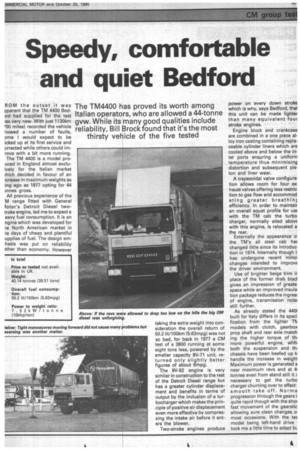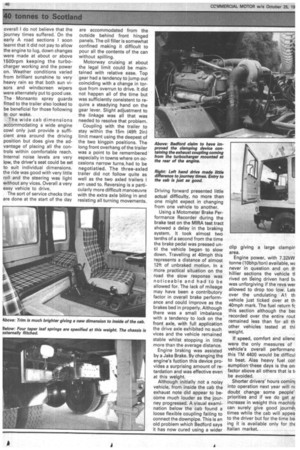Speedy, comfortable and quiet Bedford
Page 47

Page 48

If you've noticed an error in this article please click here to report it so we can fix it.
The 1M4400 has proved its worth among Italian operators, who are allowed a 44-tonne gvw. While its many good qualities include reliability, Bill Brock found that it's the most thirsty vehicle of the five tested
ROM the outset it was pparent that the TM 4400 Bed)rd had supplied for the test as very new. With just 1130km r00 miles) recorded the vehicle howed a number of faults, ome I would expect to be icked up at its first service and orrected while others could imrove with a bit more running. The TM 4400 is a model prouced in England almost excluively for the Italian market thich decided in favour of an lcrease in maximum weights as )ng ago as 1977 opting for 44 Jnnes gross.
All previous experience of the 'M range fitted with General lotor's Detroit Diesel twotroke engine, led me to expect a eavy fuel consumption. It is an ngine which was developed for le North American market in le days of cheap and plentiful upplies of fuel. The design emhasis was put on reliability 3ther than economy. However taking the extra weight into consideration the overall return of 50.2 lit/100km (5.63mpg) was not so bad, for back in 1977 a CM test of a 3800 running at some eight tons less, powered by the smaller capacity 8V-71 unit, returned only slightly better figures of about 6mpg.
The 8V-92 engine is very similar in construction to the rest of the Detroit Diesel range but has a greater cylinder displacement and benefits in terms of output by the inclusion of a turbocharger which makes the principle of positive air displacement even more effective by compressing the intake air before it enters the blower.
Two-stroke engines produce power on every down stroke which is why, says Bedford, that this unit can be made lighter than many equivalent four stroke engines.
Engine block and crankcase are combined in a one piece al loy iron casting containing repla
ceable cylinder liners which are cooled above and .below the in
let ports ensuring a uniform temperature thus minimising distortion and subsequent piston and liner wear.
A trapezoidal valve configuration allows room for four ex.
haust valves offering less restric tion to gas flow and accommod ating greater breathinc efficiency. In order to maintair
an overall squat profile for us( with the TM cab the turbo
charger, normally sited abovE with this engine, is relocated a the rear.
Externally the appearance a the TM's all steel cab ha:
changed little since its introduction in 1974. Internally though i. has undergone recent minoi changes intended to improvE the driver environment.
Use of brighter beige trim ir place of the former drab blacl gives an impression of greate space while an improved insula tion package reduces the ingresr of engine, transmission noisr still further.
As already stated the 440( built for Italy differs in its speci
fication from the lighter TI‘■ models with clutch, gearbox prop shaft and rear axle match
ing the higher torque of thr
more powerful engine, whili both the suspension and thi
chassis have been beefed up tc handle the increase in weight Maximum power is generated a near maximum revs and at 41 tonnes even from stand still it i necessary to get the turbo charger churning over to affect . smooth take off. Norma progression through the gears i quite rapid though with the shor fast movement of the gearstic allowing sure clean changes a most occasions. With the teE model being left-hand drive took me a little time to adapt bL
overall I do not believe that the journey times suffered. On the early A road sections I soon learnt that it did not pay to allow the engine to lug, down changes were made at about or above 1500rpm keeping the turbocharger working and the power on. Weather conditions varied from brilliant sunshine to very heavy rain so that both sun visors and windscreen wipers were alternately put to good use. The • Monsanto spray guards fitted to the trailer also looked to be beneficial for those following in our wake.
The wide cab dimensions accommodating a wide engine cowl only just provide a sufficient area around the driving position but does give the advantage of placing all the controls within comfortable reach. Internal noise levels are very low, the driver's seat could be set to suit individual dimensions. the ride was good with very little roll and the steering was light without any vices. Overall a very easy vehicle to drive.
The sort of service checks that are done at the start of the day are accommodated from the outside behind front hinged panels. The oil filler is somewhat confined making it difficult to pour all the contents of the can without spilling.
Motorway cruising at about the legal limit could be maintained with relative ease. Top gear had a tendency to jump out coinciding with a change in torque from overrun to drive. It did not happen all of the time but was sufficiently consistent to require a steadying hand on the gear lever. Slight adjustment to the linkage was all that was needed to resolve that problem.
Coupling with the trailer to stay within the 15m (49ft 2in) limit meant using the deepest of the two kingpin positions. The long front overhang of the trailer was a point to be remembered especially in towns where on occasions narrow turns, had to be negotiatied. The three-axled trailer did not follow quite as well as the two axled trailers I am used to. Reversing is a particularly more difficult manoeuvre with the extra axle biting in and resisting all turning movements. Driving forward presented little actual difficulty, no more than one might expect in changing from one vehicle to another.
Using a Motometer Brake Performance Recorder during the brake test on the MIRA test tract showed a delay in the braking system. It took almost two tenths of a second from the time the brake pedal was pressed until the vehicle began to slow down. Travelling at 40mph this represents a distance of almost 12ft of unbraked motion. In a more practical situation on the road the slow response was noticeable and had to be allowed for. The lack of mileage may have been a contributory factor in overall brake perform ance and could improve as the brakes bed in properly. Although there was a small imbalance with a tendency to lock on the' front_ axle, with full application the drive axle exhibited no such vices and the vehicle remained stable whilst stopping in little more than the average distance.
Engine braking was assisted by a Jake Brake. By changing the engine's fuction this device provides a surprising amount of retardation and was effective even at this weight.
Although initially not a noisy vehicle, from inside the cab the exhaust note did appear to become much louder as the journey progressed. A visual examination below the cab found a loose flexible coupling failing to connect the downpipe. This is an old problem which Bedford says it has now cured using a wider clip giving a large clampin area.
Engine power, with 7.32kW tonne (10bhp/ton) available, never in question and on th hillier sections the vehicle ft rived on tieing driven hard lot was unforgiving if the revs wer allowed to drop too low. LatE over the undulating Al th vehicle just ticked over at th 40mph mark. The fuel return fc this section although the be recorded over the entire rout remained less than for all th other vehicles tested at thi weight.
If speed, comfort and silenc were the only measures of vehicle's overall performanc this TM 4400 would be difficul to beat. Alas heavy fuel con sumptionlhese days is the on factor above all others that is ti be avoided.
Shorter drivers' hours comim into operation next year will n( doubt changesome people': priorities and if we do get at increase in weight this machim can surely give good journe) times while the cab will appea to the driver but for the time be. ing it is available only for thE Italian market.
























































































































































